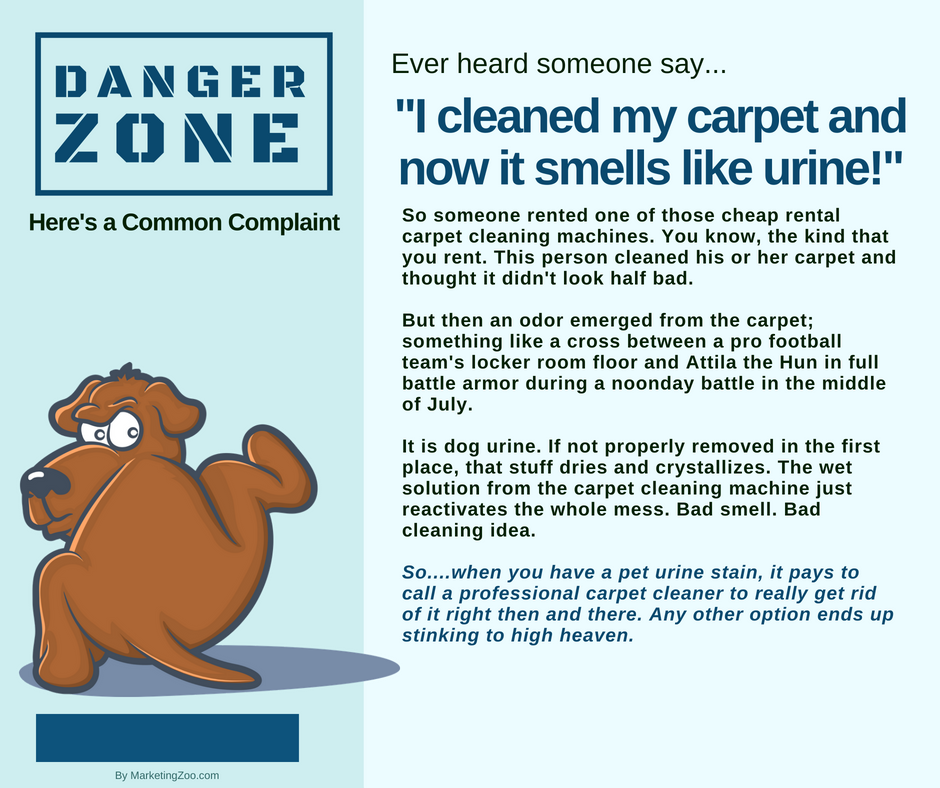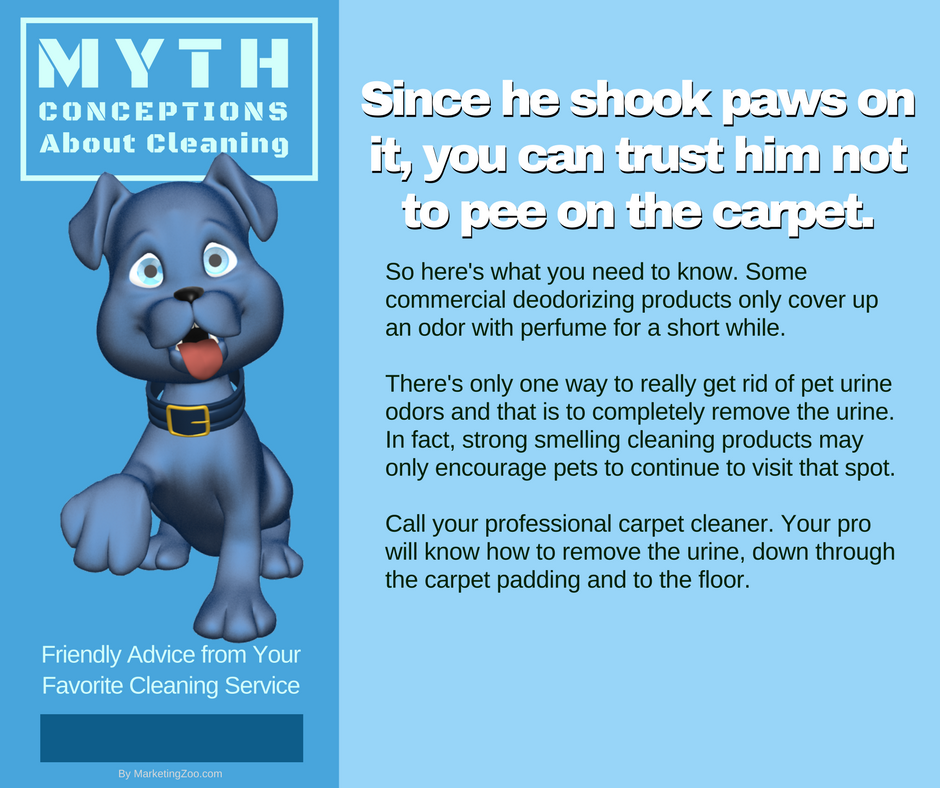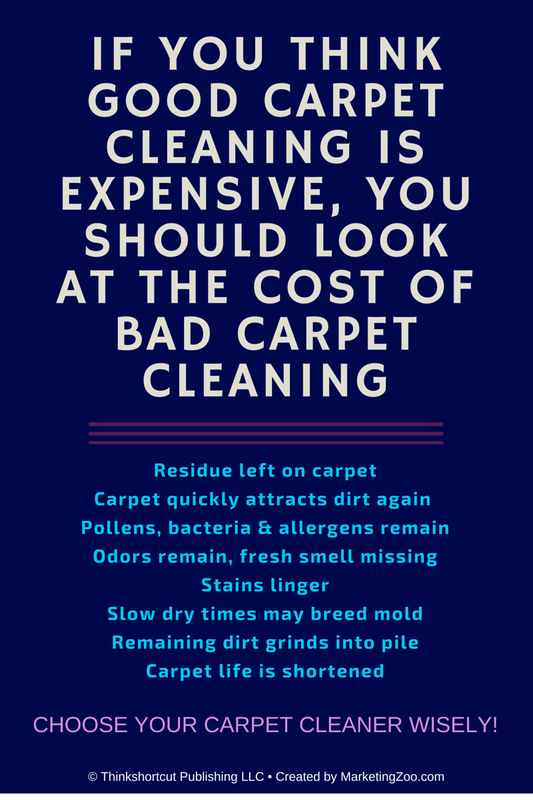How To Remove Dog Urine Odor
From Carpet
Without question, a dog can be oh so cute, except, when there is dog urine odor in the carpet. Until the smelly odor is removed, the dog is less than man's best friend.
Whether its an accident or on purpose, dog odor can be a source of embarrassment and frustration. Insufficient urine odor removal is an open invitation for the pet to go back to this marked territory.
Permanent staining of the carpet can result the longer this unsanitary contamination remains untreated.
A common statement from many a dog owner is: "I have repeatedly cleaned the urine affected area but the odor is still there".

Why is odor from dog urine so difficult to remove?
One of the main components of dog urine is uric acid. This uric acid forms uric acid crystals, otherwise known as urine salts, and is the reason for the offensive odor.
As the liquid content of the urine evaporates, the odor from the urine salts is minimized. When the uric acid crystals absorb moisture from humidity in the air or from a cleaning product, the urine salts give off the unmistakable odor.
Scientifically speaking, dog urine is on the acid side of the pH scale as it is excreted from the dog. As the urine dries, however, the urine changes from the acid side to the alkaline side of the pH scale.
This is important to know because most carpet cleaning products are formulated on the alkaline side of the pH scale. Most soil is acidic and is most efficiently cleaned away with an alkaline based cleaner. Whereas alkaline based soil (including pet urine) is most efficiently cleaned with a cleaner on the acid side of the pH scale.
Acids neutralize alkalines and vice versa. Alkaline based cleaning products have little cleaning ability on alkaline based soils.
Urine odor can persist even after cleaning the carpet because the urine in the carpet backing and padding has not been addressed. Cleaning the carpet surface may make you feel better but will do little in removing the offending odor.
What procedures do we follow to remove dog urine odor?
1. Locate the odor source:
Dogs tend to excrete in the middle of the room. They will occasionally pee against a wall or even on furniture like a chair leg or sofa skirt. Compared to cat urine, dog odor is easier to correct but is more difficult to locate since dogs are unpredictable and tend to go "anywhere". We look for visible evidence in the form of spots or discolorations.
Visible evidence however, is not always readily seen when cleaning pet urine contamination. For instance, older dogs can develop a urine "drip" where a dog leaking droplets throughout a room, can over time, create a detectable odor without anyone being able to pinpoint an exact location.
To assist us in locating the odor source we use a "black (ultraviolet) light". The black light works best in a darkened room. As the ultraviolet light passes over the carpet, the urine salts become fluorescent and give off a yellow green "glow". The black light is especially useful in revealing just how busy your dog has been.
Another tool in our arsenal is an electronic moisture detector. The moisture detector is extremely sensitive to the moisture and sticky residues found in urine deposits. These urine crystals or salts never completely go away on their own and will always be present to some degree no matter how old or dry the carpet is. As the salts age, they may not give off as strong of on odor as when freshly deposited, but they still can be an attraction to a dog's nose.
For instances where there is a dog odor in a room but no apparent location, we rely on our nose, the most available and practical method of locating the source of urine. When all other tools fail, getting down on our hands and knees may be the only discovery technique.
2. Assess the extent of odor contamination:
Generally speaking, the smaller breeds seem more likely to be "carpet wetters" than larger dogs. My experience has been 99 times out of 100, inquiries concerning dog urine odor removal services, are due to small dogs.
Even though a larger dog can release more volume, a smaller sized dog can excrete enough urine to wet the carpet face, the backing, the padding (if present), the wooden tack strip (if present on wall to wall carpet installation) and the sub-floor (hardwood, plywood or concrete).
The extent of the dog urine contamination will determine the course of action taken to remove the odor source. Unless the dog has been allowed to repeatly use the carpet as a toilet, the problem can usually be effectively treated and corrected without the need to remove and replace the padding, tack strip or seal the sub-floor. Even in some extreme cases, we can often correct a urine odor issue without replacing padding, etc.
In cases of large area and overall contamination, the carpet should be disengaged from the tack strip and inspected from the back to determine the scope of the problem. Due to some situations where a room is filled with heavy or unmovable furniture, it's not always possible to peel the carpet back to see the contamination underneath. Assessing the extent of the contamination in this instance can only be done through the carpet face.
Once the severity of the contamination is evaluated, the cost to correct verses the cost to replace the carpet can be determined. Depending on the carpet age, wear and extent of contamination, the cost to correct is generally less than the cost of new carpet.

3. Remove the odor source and clean the surface where the dog urine odor exists:
The
process of cleaning the surface begins by removing the urine salts
which cause the odor. The largest concentration of urine salts will be
in the carpet backing and padding. The affected area of the carpet needs
to be saturated with an acidic solution designed to liquify urine
crystals so they can be rinsed away.
Enough
solution is applied to recreate the "crime", to reach wherever the
urine has gone (the carpet surface, backing, padding, etc). This
liquified contamination is then extracted from the affected area and the
carpet surface is thoroughly cleaned and ready for the deodorizer.
4. Apply a suitable deodorizer to eliminate any remaining dog urine odor:
The
purpose of the deodorizer is to counteract and destroy any remaining
urine salts. Eliminate the remaining urine salts and the odor will no
longer exist. The carpet or affected upholstery is saturated with the
deodorizer in much the same way the the solution in step 3 above was
applied and extracted. The deodorizer begins working to destroy the odor
and as the carpet dries, the odor goes away.

return from Remove Dog Urine Odor to the Odor Removal page
Recent Articles
-
The Carpet Cleaning Guide: What To Expect Before, During and After
Jul 19, 20 02:11 PM
Finally, a carpet cleaning guide designed to take the stress out of having your carpet cleaned. Learn how to navigate the entire cleaning process and save money. -
Carpet Cleaning, Serving Bucks County, PA and Montgomery County, PA
Jun 18, 20 09:38 PM
Searching for carpet cleaning in Bucks County PA or Montgomery County PA. Call 215-482-8304 for a cleaning experience your rave to everyone about or it's free -
Contact Us
Oct 02, 19 07:02 AM
Use this form to contact us with any questions or comments about the cleanhealthycarpet.com website.


New! Comments
Have your say about what you just read! Leave me a comment in the box below.